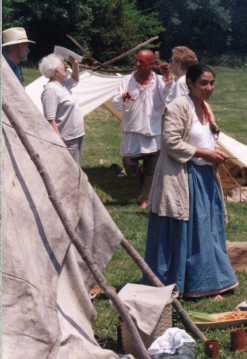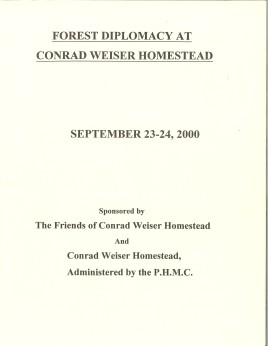There’s a difference between visitors attending a living history event and visitors interacting with the event – it can be the difference between going to a concert and sitting in with the band. It’s easy for many living history interpreters to think they’re engaging to visitors by being accurately informed, dressed, and equipped. Sometimes those very achievements, which can feel foreign and unapproachable or which have assumed new meanings in the modern world, can make it difficult for visitors to want to talk with interpreters. This has led many interpreters to unfairly ridicule visitors for asking “dumb” questions or appearing uninterested.
One way to lower these barriers is to create a visitor guide. Unlike a schedule, which tells visitors where and when events are happening, a guide can help shape the entire visitor experience, even well after the event.
A good guide does a few things:

Plus the guide makes a great sunshade while talking with interpreters.
- Orients people to the event’s physical landscape and story.
- Introduces visitors to who they will meet – you can’t tell the players without a program – and how they are part of that story.
- Can be tailored to be as general or as specific as the event requires.
- For museums, it is an opportunity to share resources and highlight relevant books available in the shop.
- It’s a visible way to attract and recognize sponsors.
- Offers icebreaker questions to help visitors engage with interpreters.
This last one might seem novel. It’s not simply leading people to say what we want them to say. If you offer suggested icebreaker questions, the usual “are you hot?,” “is that real?,” and “do you always dress this way?” (valid questions themselves) are quickly bypassed and richer conversations can happen. It helps bring all of the preparatory work – the researching and recreating – into focus and allows living history to more effectively do what it does best: share the revelations of personal stories and material details.
As mentioned above, visitor guides can be as general or as specific as the event or event circumstances call for. Below is an overview of three events that have used visitor guides and icebreaker questions. Each had their own needs, opportunities, and lessons.
“To Wipe Off the Tears”
In 2002 I produced a five-part series focused on the events of the French and Indian War-era Treaties of Easton. It included three living history events and two formal lectures, all at separate locations. These events were developed with a few goals in mind – 1. to introduce Lehigh Valley residents to this little-known, yet internationally important local event. 2. To put great interpreters in front of the public. 3. To narrow the gap between visitors and interpreters as much as possible.

None of this is my idea. I was inspired by the Schoenbrunn Village interpreters and the “Forest Diplomacy” event and visitor guide.
Taking inspiration from other events I had participated in, I put together an interpretive plan, a resource list, and a visitor guide. Because we represented diverse groups and individuals involved in the treaties, including various Native nations, colonial officials, missionaries, religious figures, and tradesmen, there was a lot for visitors to take in. It would have been easier to let the interactions happen on their own, but I was worried that the events would then quickly devolve into visitors simply gawking at the interpreters and vice versa.
The guide was written to help people move through each event and across all five events. Brief backgrounds and introductions were written and a question tailored to each individual or group was included.
The guide encouraged and indicated groupies. We had people who came to every event. It was easy to spot them because they had written notes all over their guides.
Fort Ticonderoga’s 2009 Grand Encampment
While I was on staff at Fort Ticonderoga I inherited the reenactments. Among our most popular events, they also offered great potential for increased visitor interaction. Since they were established events, I was unable to hand-pick the living history participants, which meant we had no way to know the quality of every interpreter attending or of the potential interpreter-visitor interaction. I wrote a guide for our French and Indian War Grand Encampment to help make it more visitor-focused and friendly.
The Grand Encampment guide included FAQs about the reenacting and our reenacted battles. I wanted to answer those more modern questions before they got to any interpreters, so face-to-face interactions could focus on history.
The guide was also meant to help visitors compare and contrast the experiences of each combatant group, Native, British, and French. The questions were written so that all three could be asked the same questions and visitors would hear very different answers from each. This was also a way to make sure we presented each group equally.
The Ticonderoga event was larger than any of “Tears” events, so it was harder to gauge the effectiveness of the guide. As before, visitors used it to start conversations and record thoughts and notes, but I have little sense of how common that was. What was clear was that we handed out all of the printed guides, yet found few littering the site or in the trash. Hopefully that meant people took them home and used them to continue exploring the French and Indian War.
Occupied Philadelphia
In October of 2017 the Museum of the American Revolution in Philadelphia hosted “Occupied Philadelphia.” This two-day living history event included several recreated British regiments and civilian interpreters occupying three sites throughout Old City Philadelphia. The event was structured so that walk-ons could spend time at any or all of the sites, but to have the full, “unlocked” experience, guests took a guided tour of the sites. The Museum’s education and curatorial staff put together a visitor guide for the weekend, including a map of participating sites, a brief background on the British occupation of the City in the winter of 1777-78, and icebreaker questions.
As a site coordinator, I had a much more active public role in this event than the others mentioned above. This left me less time to observe how guests did or did not use the guide. What I did notice is that guests had the guide in their hands, but rarely opened it. Instead their focus was on the tour guide who introduced the officer, and then on the officer who proceeded to energetically interpret. When finished, the officer invited people to talk with the enlisted men and women in small, more casual groups. Instead of the visitor guide’s questions, these conversations were focused on the clothing and equipment the interpreters were wearing. This format was a much more directed experience than “Tears” or the Grand Encampment.
These interactions were not only directed, they were, by design, short. The structured nature of the tour seemed to reduce the effectiveness of the guide. The timed tour gave potential interactions an artificial, but real, ending. When the guided guests left to go to the next stop that often signaled to walk-ons that it was time to go too.
This is not to say that the event was not interpretively successful. Instead of the paper guide, guests had a human guide to help them navigate the experience. Further evidence that no paper guide can truly replace effective personal interactions. Nor should it try to.
Outcomes
Admittedly, the following outcomes are based on anecdotal evidence and personal observation, but I have used these guides for a few different events now and have found them effective. My observations include:
- Visitors and participants said they valued how the guide helped them navigate the event’s opportunities.
- Guests and interpreters stayed in conversation longer, and both left feeling positively about the interaction.
- The guide and icebreaker questions are most effective when an intermediary guide is unavailable and when there is time for longer, less structured interactions.
- Many people started with the suggested icebreaker questions, but quickly asked their own.
- The printed questions demonstrated the interactive nature of the events and inspired some people to ask their own questions right away.
- Having the suggested reading list increased book sales.
- There was an awareness of who was running the event (a museum), who was participating (reenactment groups), and that they were different.
- Sharing the guide with the interpreters well in advance allowed them to know what to expect. A few even suggested better ways to frame their particular piece of the story.
Perhaps the most heartening result of these guides is that they helped people overcome whatever hesitation or uncertainty they had in talking to interpreters. During “Tears” and the Grand Encampment it was wonderful to watch some people read, almost rehearse the icebreaker questions before approaching an interpreter, ask the questions, and quickly start asking their own. Sometimes those questions were a deeper dive into the brief histories included in the guides (which might be all the history of that topic they had ever seen), and sometimes they went in different directions. Using those brief backgrounds and icebreaker questions helped give guests the invitation they needed to feel comfortable talking about things they probably hadn’t thought much about or knew of before the event. Standing in front of a strangely-dressed “authority” isn’t always the optimal time to find one’s words. Since not everyone is already a historian, the guides gave guests the tools (background and conversation starters) to engage with the event quickly and intelligently.
Certainly visitor guides add more work to your event, but experience suggests it’s worth it. An effective guide increases engagement, curiosity, and satisfaction for visitors and interpreters alike. Write one for your next event and see if it makes a difference. And let me know what you find.
__________________________________________________
I would like to thank my colleagues Mary Jane Taylor, Kimberly D. Boice, and Tyler R. Putman and my wife Jane Coughlin for their comments and support.

Great read – and you’re spot on! The interpreters do make the difference between good and so-so. Blessings,
LikeLike
Thanks, Bill.
LikeLike
Mark,
I’ve been asked to give a presentation at an event in the mid-west in late October of this year. I would like to use portions of this post as the basis for my presentation, in particular the visitor guides.
Would this be acceptable?
LikeLike
Jay,
First, thanks for thinking this is worth sharing, but on The Endeavor and at your presentation.
Please feel free to use the guides. My only request is you also share the post in any materials or during your presentation.
Good luck with your presentation.
Thanks,
Mark
LikeLike
Mark,
Thank you. If you can think of any other resources I can use for my presentation, please let me know.
Jay.
LikeLike